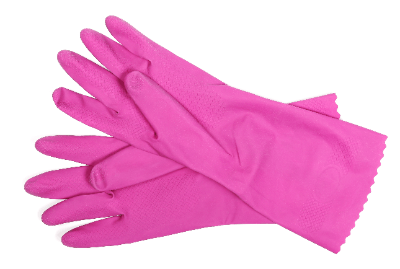What Is a Rubber Glove?

Rubber gloves are gloves worn when working with water or cleaning grease.
There are two types of rubber gloves: latex gloves made of natural rubber and nitrile gloves made of synthetic rubber.
Other types of gloves for professional use include polyethylene gloves for handling foodstuffs and PVC (polyvinyl chloride) gloves, which do not allow direct contact with food but are resistant to oil and chemicals.
Uses of Rubber Gloves
Latex gloves made of natural rubber are used in a wide range of household and industrial applications. Specific uses include the following:
- Waterwork and car washing
- Sanitary work such as gardening and garbage disposal
- Work with slightly sharp objects
However, no chemicals or oils must be used.
Nitrile Gloves
Nitrile gloves made of synthetic rubber are resistant to chemicals and oil. Specific uses are as follows:
- Work with machinery
- Work with oil and kerosene
- Paint and spray painting
- Chemical experiments
- Food processing work
- Medical or cleaning work
Principles of Rubber Gloves
As mentioned above, rubber gloves are broadly classified into “latex gloves” and “nitrile gloves,” each with different principles.
1. Latex Gloves
Latex gloves are made by molding natural rubber. They are characterized by their non-slip and high flexibility. Because they are comfortable and strong in the hand, they can be used for long hours.
However, they have the disadvantage of being sensitive to oil, chemicals, and solvents. In addition, the protein and other substances contained in natural rubber may cause allergic contact dermatitis, so care should be taken.
2. Nitrile Gloves
Nitrile gloves are made of synthetic rubber. They are resistant to oil and chemicals and are characterized by their strength. They have excellent anti-insertion properties and fit the hand so well that they feel like bare hands, but they are somewhat less flexible. Nitrile gloves also require caution because allergies involving rubber and vinyl chloride resin additives may occur.
Other Information on Rubber Gloves
1. Allergy to Rubber Gloves
Some rubber gloves are made of natural rubber, and repeated contact with them can cause allergies. This is called latex allergy and can cause immediate allergic reactions such as urticaria, asthma attacks, and anaphylactic shock at the site of contact and throughout the body. Particular attention should be paid if you use rubber gloves frequently, or if you have an atopic constitution.
The allergen is latex protein, which is contained in about 1.5% of the white sap (latex) of the para rubber tree, the raw material of rubber gloves, and enters the gloves through the skin and mucous membranes. The only preventive measure is to avoid natural rubber products.
In Japan, latex allergy warning labels became mandatory in 1999. Therefore, it is recommended to check for latex-free products at the time of purchase and choose latex-free gloves.
2. What Are Nitrile Rubber Gloves?
Nitrile rubber gloves are gloves made of synthetic rubber called nitrile rubber. Therefore, they are one of the latex-free rubber gloves that do not use natural rubber.
They are characterized by their resistance to oil and chemicals and their durability. In addition, these gloves fit the hand without any gaps, so they are close to the feeling of bare hands, making them ideal for detailed work. They are often used in medical and nursing care settings.
Since the spring of 2020, nitrile rubber gloves have been in short supply and prices have skyrocketed due to the spread of the novel coronavirus. Malaysia accounts for about two-thirds of the world’s production of nitrile rubber, and current prices are several times what they were before the coronavirus epidemic.